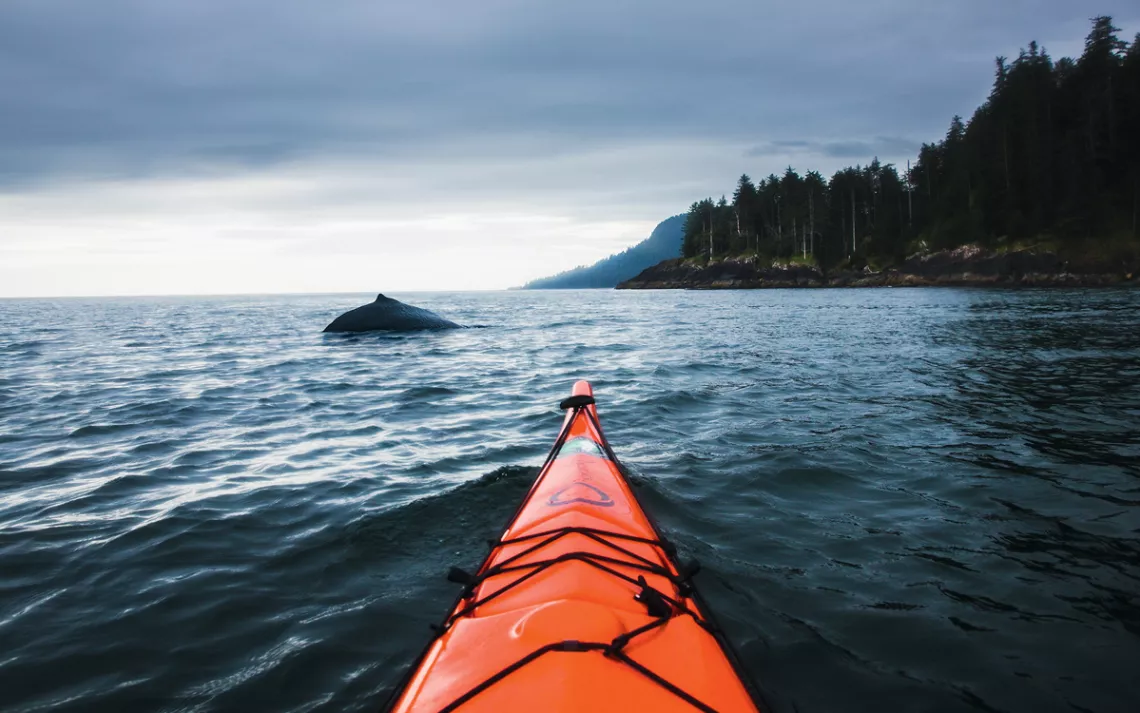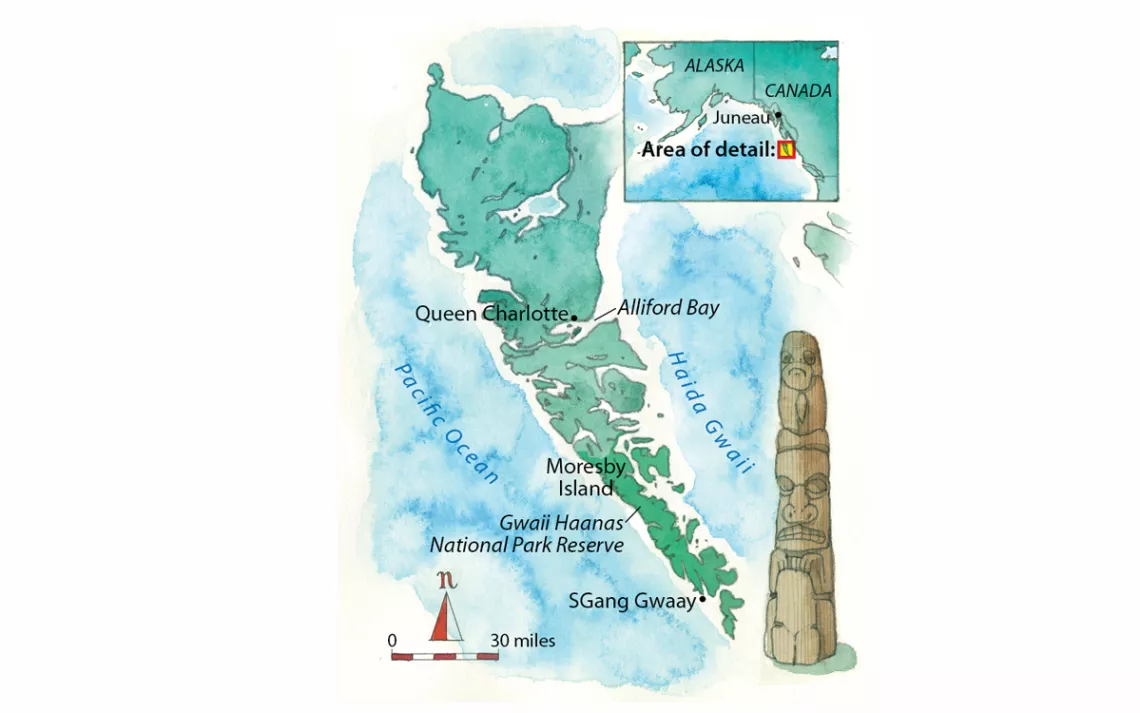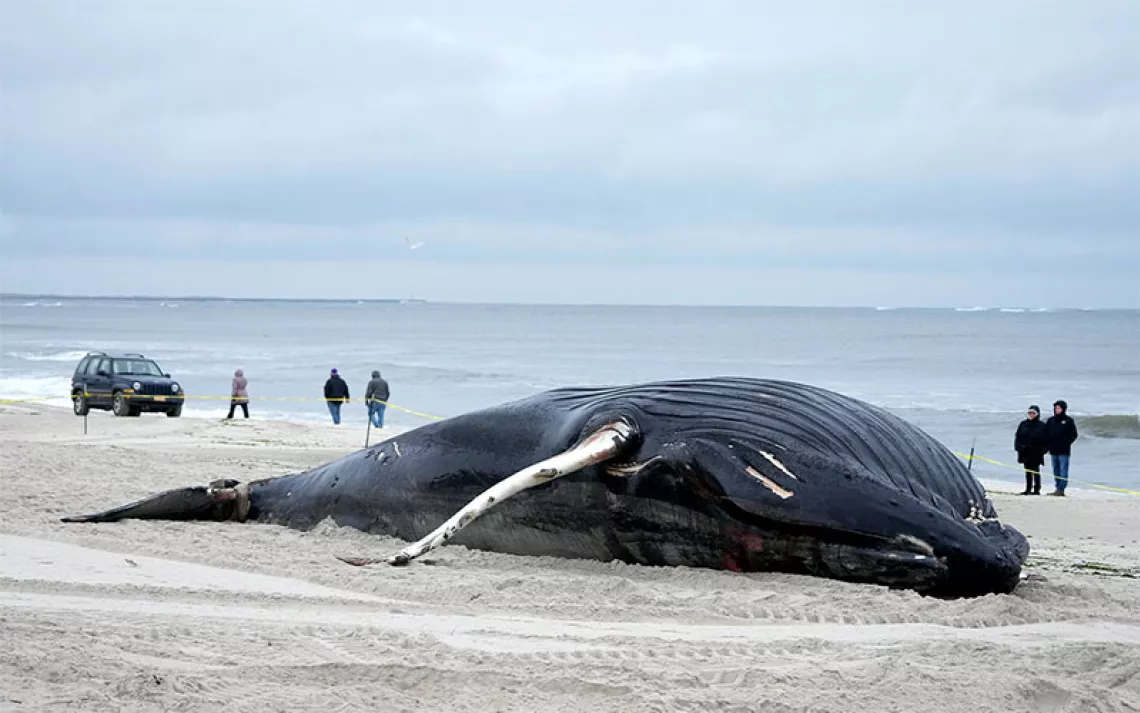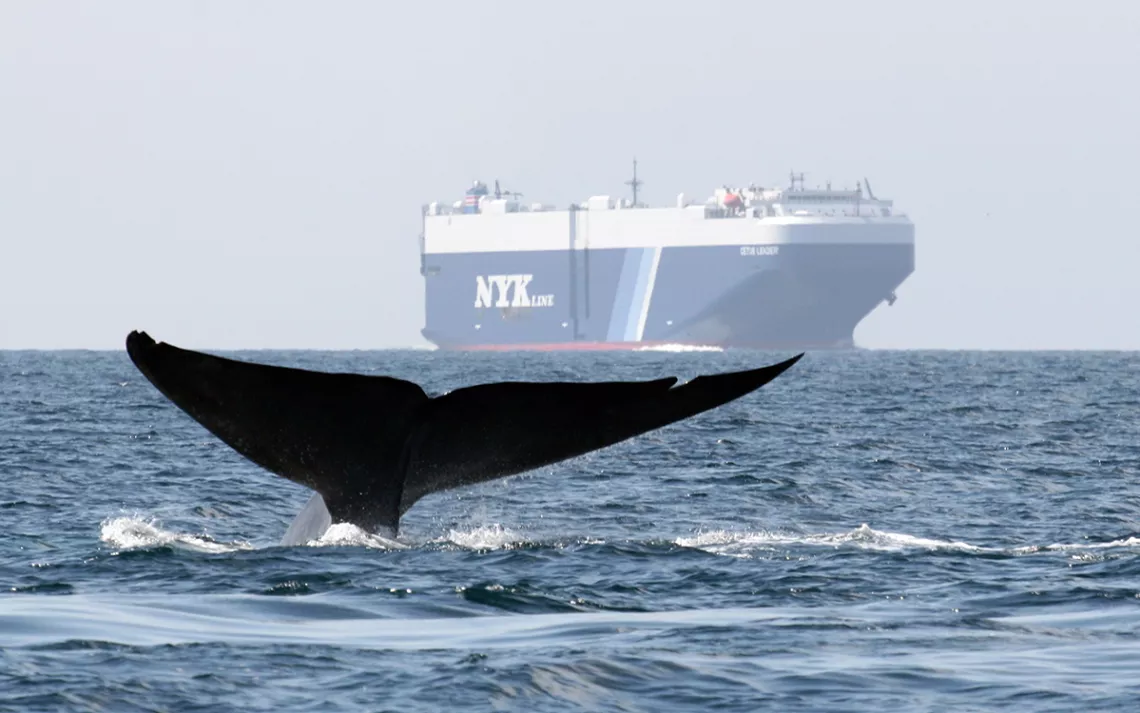What It's Like to Kayak With Whales in Haida Gwaii
Where orcas rule the waves and Indigenous elders protect the land

In March and April, lucky kayakers may cross paths with gray whales cruising the extensive archipelago of Haida Gwaii. | Photo by Andrew Tomayko
From my plane window, the islands of Haida Gwaii rise from the Pacific mist like mountains floating in the sky. The chain of 150 moss-draped isles, 62 miles off the northern tip of British Columbia, is known as the Galápagos of the North for the many plant and animal species that exist there and nowhere else. One of the most isolated locations on Earth, it's a place where ancient forests of cedar and Sitka spruce soar hundreds of feet into the air, black bears prowl the shores, and orcas rule the waves.
Haida Gwaii—known as the Queen Charlotte Islands until 2010—is also one of the top sea-kayaking destinations in North America. Numerous routes circumnavigate Gwaii Haanas National Park Reserve, located on Moresby, one of the archipelago's two main islands. Most routes take paddlers to one of Haida's most treasured cultural sights, SGang Gwaay. This ancient village, abandoned in the 1880s, contains a magnificent collection of carved poles and remains a potent spiritual and historical site for the Haida people, who have lived on these islands for at least the past 12,500 years.
Each spring, gray whales migrate through the archipelago and Alliford Bay, which surrounds the tiny villages of Skidegate and Queen Charlotte. To find the whales, I teamed up with Green Coast Kayaking, one of Haida Gwaii's most respected eco-tour operators. The plan was to spend three days paddling the bay—where the whales are known to scratch their skin against the rocks near the shore—and to camp on the deserted beaches of remote islands.
The first day, our group of four put in at the Queen Charlotte docks and paddled roughly five miles southwest to Lina Island for a picnic of candied-salmon salad with dill and fresh tomatoes. The next day, we headed three miles south, crossing a narrow channel on the western edge of Maude Island and tracing its southern shore back east, where we thought the whales might be. Along the way, bald eagles soared above and seals bobbed curiously behind. We ate kelp straight from the ocean and spruce tips from a tree. When the sun shone on the water, paddling was like gliding on stretched velvet. When squalls blew, the sky swirled in mists of blue and gray, brooding clouds, and sudden shafts of rainbow.
We didn't spot any whales that day, but we did find something special: Haina. Community elders granted us permission to visit their ancient Haida village site on the eastern point of Maude Island. Emerging from the sea was like stepping back in time: We could see holes where monumental poles once stood, and the straight, embossed lines of longhouses poking up through the moss and fern that are slowly reclaiming the structures. The fact that anything at all remains in Haina and elsewhere on the islands is in large part thanks to one man.
I met Captain Gold, a renowned Haida elder, back on dry land at the end of my trip. In 1973, fed up with the degradation of Haida heritage sites, mostly from neglect and visitor damage, Gold got in his canoe, paddled 150 miles from his home on the archipelago's largest island, and set up camp beside the then-unprotected site of SGang Gwaay to keep watch over it during the high-traffic summer.

Map by Steve Stankiewicz
At the time, people thought Gold was crazy. But his idea changed these islands forever, as it helped lead to the formation of the Gwaii Haanas National Park Reserve (now run in conjunction with the Haida), to SGang Gwaay being designated as a UNESCO World Heritage Site, and to the founding of Parks Canada's Watchmen program, which employs Native people to educate visitors at key ancestral sites and to monitor fisheries, forests, and other resources. That model of Indigenous-led conservation has since inspired other First Nations people, including the Tseshaht along the coast of Vancouver Island, to adopt similar strategies. "It's about pride," Gold explained. "I want to allow these places to return to the earth with dignity."
It's not all happy endings, of course. Canada's First Nations face many obstacles, and Haida Gwaii is no exception: Logging, overfishing, and pipelines are major, ongoing concerns. But Captain Gold's Watchmen program is a seed for a new form of conservation marked by values passed down through millennia: coexistence, respect, and humility. Haida culture, he says, is resurging.
But still, two days in and no whales. Then, paddling back on our last day, we saw spume in the distance, then dark shapes breaching the surface like shadows on waves. We kept our distance, but as we waited, the sprays came closer. I felt the water ripple around me, the kayak shake. Then suddenly, without warning, a gray whale broke through the surface less than 10 feet away. My heart raced: At 50 feet long, it was a genuine monster of the deep, blowing air, its breath smelling of the ocean. But it was gentle too, a sentient being. And its presence momentarily united our two worlds, land and sea. Just as Haida Gwaii does.
Take a Sierra Club trip to British Columbia. For details, see sc.org/adventure-travel.
This article appeared in the July/August 2019 edition with the headline "Paddling Among Giants."
WHERE
Haida Gwaii, off the northern coast of British Columbia, Canada
GETTING THERE
While it's possible to reach the islands via ferry (a 16-hour ride from Vancouver Island's Port Hardy to Port Prince Rupert in northern British Columbia plus another eight-hour ferry to Haida Gwaii), most visitors fly direct from Vancouver to the airport at Sandspit. From there, it's about an hour by taxi to Queen Charlotte.
GETTING AROUND
If you're just kayaking or traveling with an organized tour, a rental car isn't required. But if you're hoping to explore other parts of the archipelago, it's essential.
WHEN TO VISIT
Whale-spotting season is March through October; July and August offer the best chances for orca sightings and the driest weather.
MUST-SEE
The ancient village of SGang Gwaay, in Gwaii Haanas National Park Reserve—the islands' best-preserved Haida cultural site.
PRO TIP
Bring wet-weather gear: neoprene pants, gloves, and a proper paddling jacket.
BOOK IT
A three-day guided tour with Green Coast Kayaking (gckayaking.com) costs about $600 per person, including all meals and equipment.
UNEXPECTED FUN
Staying at the Float House in Queen Charlotte, a cozy houseboat with a wood-burning fireplace, right on the shores of Alliford Bay.
 The Magazine of The Sierra Club
The Magazine of The Sierra Club



